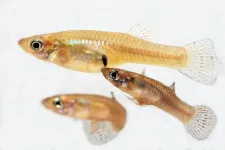(Press-News.org) Many people instinctively associate mucus with something disgusting, but in fact, it has incredibly many valuable functions for our health. It keeps track of our important intestinal flora and feeds the bacteria. It covers all internal surfaces of our body, and, as a barrier to the outside world, it helps us protect ourselves from infectious diseases.
This is because mucus acts as a filter that keeps the bacteria in or out, and the bacteria feed on the sugars in the mucus between meals. So, if we can produce the mucus that is already present in the body with the right sugars, it might be used in brand new medical treatments.
Now, researchers from the DNRF Centre of Excellence, Copenhagen Center for Glycomics, have discovered how to artificially produce the healthy mucus.
'We have developed a method for producing the important information found in human mucus, also called mucins, with their important sugars. Now, we show that it is possible to artificially produce it in the same way as we produce other therapeutic biologics today, such as antibodies and other biological medicine', says Professor Henrik Clausen, lead author of the study and Director of the Copenhagen Center for Glycomics.
The mucus, or mucins, consist mostly of sugars. In the study, the researchers show that it is actually special patterns of sugars on the mucins that the bacteria recognise.
'It is the body's way of selecting the good bacteria and deselecting those that cause diseases. And it is precisely the sugars in the mucus that we are now able to design as needed', says first author of the study, Ph.D. student Rebecca Nason.
The researchers are particularly interested in the mucus in the gastrointestinal tract. Like a giant fishing net, the mucus keeps track of all the bacteria, our microbiome, down there. So, if one could imitate the ability of bacteria to attach to the intestinal mucus, one could design oral medications that stick to the mucus, making them more effective.
'We have found a small molecule from bacteria - which we call X409 - that binds to the intestine, and that is precisely one of the many possibilities we are now working on', says Rebecca Nason.
It can be difficult to get medicine to be effective when it has to be ingested and absorbed into our intestinal system. So, when you design your drug as a pill that the patient swallows, it is not certain that it will be fully efficient.
There are many obstacles on the way down through the digestive system, and the medication needs time in the gastrointestinal tract to be dissolved and distributed in the body', explains Rebecca Nason.
We swallow more than a litre of mucus in the form of saliva per day and more from the stomach, which together with the ever-changing fishing net of mucus in the intestine feed our intestinal microbiome. The microbiome of the intestine is absolutely crucial to our health and of great importance in relation to many diseases.
'An incredible number of diseases have a connection to the intestinal flora, but we still know very little about how we can control the intestinal flora in the treatment of diseases. This is where synthetic mucins could open up new treatment options', says Associate Professor Yoshiki Narimatsu, another of the lead authors of the study.
'Ultimately, one can imagine using mucins as a pre-biotic material, that is, as molecules that help the good bacteria in the body', says Yoshiki Narimatsu.
With artificial mucus, it will also be possible to alleviate infections in the body. Mucus in saliva flushes out bacteria and cleans the oral cavity, and mucus constantly runs down over our eyes and keeps them clean.
'We imagine that instead of using antibiotics, you might produce for example eye drops with the mucin that normally removes the bacteria in the treatment of eye infections. In concrete terms, this means that mucin can dissolve the so-called biofilm of bacteria, which is often pathogenic', says Yoshiki Narimatsu.
Biofilm is a film of bacteria on the surface of a material and is, among other things, what you can feel on your teeth if it has been a long time since you last brushed them.
It is not only bacteria that recognise mucins.
'We also show that mucins are very important for the way in which the common flu virus infects our mucous membranes in competition with mucins which inhibit the infection and flush out the virus', says Yoshiki Narimatsu.
Unlike the covid-19 virus, influenza virus binds to a sugar, which is found on all mucins, and a sugar has already been developed for treatment of the flu.
'We hope mucins may work even better', says Yoshiki Narimatsu.
INFORMATION:
Physicists of Ruhr-Universität Bochum (RUB) have taken spectacular pictures that allow the ignition process of plasma under water to be viewed and tracked in real time. Dr. Katharina Grosse has provided the first data sets with ultra-high temporal resolution, supporting a new hypothesis on the ignition of these plasmas: In the nanosecond range, there is not enough time to form a gas environment. Electrons generated by field effects lead to the propagation of the plasma. The nanosecond plasma ignites directly in the liquid, regardless of the polarity of the voltage. The report from the Collaborative Research Centre 1316 "Transient Atmospheric Pressure Plasmas: from Plasma to Liquids to Solids" has been published in the Journal of Applied Physics and Rubin, the ...
COLUMBUS, Ohio - Female vampire bats establish an egalitarian community within a roost rather than a society based on a clear hierarchy of dominance that is often seen in animal groups, a new study suggests.
Researchers observed more than 1,000 competitions for food among a colony of 33 adult female bats and juveniles living in captivity, assigning a rank to each bat based on a calculation of wins and losses in those contests.
The team found that, unlike in many mammal societies, the higher-ranking animal didn't necessarily win every bout over food, and there was a randomness to the ranking order - no specific quality they measured gave a bat a better chance at dominance, so any adult female had an equal opportunity to rank very high or very low on a scale of ...
Environmental education provision needs greater investment and innovation if future generations are to be able to respond fully to the climate emergency, experts have said.
The deepening environmental crisis will continue to worsen if there is not significant support and investment in environmental and science education, researchers have warned. Reforms would help young people to address the complex, interlinked and dynamic issues of our contemporary situation.
The experts argue Governments and other organisations must direct more funding to education innovation in response to consistent warnings from scientists about trends in the deteriorating state of ecosystems, biodiversity and climate, amongst other environmental issues.
Writing in Environmental Education ...
In mosquitofish, of the genus Gambusia, male fish are smaller than females - sometimes only half the size. Biologists had previously assumed that smaller male mosquitofish had at least some reproductive advantages. Researchers from the transregional collaborative research centre NC³ at Bielefeld University have shown in a systematic review and meta-analysis that larger mosquitofish are actually more successful at reproduction: they can, for instance, better challenge their rivals; they produce more sperm; and they are preferred by female fish. The re-searchers are presenting their findings today (07.07.2021) in the Journal of Animal Ecology.
Mosquitofish are small fish with nondescript coloring of the genus Gambusia, which contains some 45 species. ...
There are some large shield volcanoes in the world's oceans where the lava is usually not ejected from the crater in violent explosions, but flows slowly out of the ground from long fissures. In the recent eruption of the Sierra Negra volcano in the Galapagos Islands, which lie just under a thousand kilometres off South America in the Pacific Ocean, one of these fissures was fed through a curved pathway in June 2018. This 15 kilometre-long pathway, including the kink, was created by the interaction of three different forces in the subsurface, Timothy Davis and Eleonora Rivalta from the GFZ German ...
Driving through a tunnel is a challenging and risky task. Drivers need to lower their speed and adapt to poor light, while the enclosed space may make them anxious. Preventing accidents is a public health challenge that uses insights from engineering, psychology, physiology, and neuroscience. Here, in a virtual reality (VR) study in Frontiers in Psychology, scientists from China, Canada, and the USA show that playback of slow music inside tunnels can reduce tension and fatigue in drivers, making them less prone to speeding and overtaking. These results imply that well-chosen background music can help improve road safety.
"When drivers go through a tunnel, they need to process a large amount ...
How do predators know to avoid brightly-coloured toxic prey? A collaboration of researchers has put social information theory to the test in a reliable real-world system to find the answer - by copying what others do, or do not, eat.
An international team of researchers from Finland, New Zealand, Colombia and the U.K. have provided the first evidence that wild birds can learn to avoid distasteful prey by observing what others eat.
"We've known for a long time that predators, like birds, associate brightly coloured warning signals with the danger of eating certain prey types. However, ...
Imagine a dust particle in a storm cloud, and you can get an idea of a neutron's insignificance compared to the magnitude of the molecule it inhabits.
But just as a dust mote might affect a cloud's track, a neutron can influence the energy of its molecule despite being less than one-millionth its size. And now physicists at MIT and elsewhere have successfully measured a neutron's tiny effect in a radioactive molecule.
The team has developed a new technique to produce and study short-lived radioactive molecules with neutron numbers they can precisely control. They hand-picked several isotopes of the same molecule, each with one more neutron than the next. When they measured each molecule's energy, they were able to detect small, nearly imperceptible changes of the nuclear ...
BOSTON - The numbers of cancer screening tests rebounded sharply in the last quarter of 2020, following a dramatic decline in the first months of the COVID-19 pandemic, at one large hospital system in the Northeastern United States. These findings were released in a study published in Cancer Cell. The research also found an increase in racial and socioeconomic disparities among users of some screening tests during the pandemic.
Study co-senior author Toni K. Choueiri, MD, director of the Lank Center for Genitourinary Oncology at Dana-Farber Cancer Institute, said following a dramatic decline during the first pandemic peak, there was a "substantial increase in screening procedures during the more recent periods ...
LAWRENCE -- A new paper appearing in Biology Letters describes the oldest-known fragmentary bat fossils from Asia, pushing back the evolutionary record for bats on that continent to the dawn of the Eocene and boosting the possibility that the bat family's "mysterious" origins someday might be traced to Asia.
A team based at the University of Kansas and China performed the fieldwork in the Junggar Basin -- a very remote sedimentary basin in northwest China -- to discover two fossil teeth belonging to two separate specimens of the bat, dubbed Altaynycteris aurora.
The new fossil specimens help scientists better understand ...


